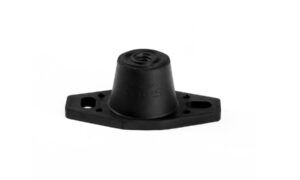Rubber Vibration Isolator Mounts for Effective Vibration Isolation
Welcome to the world of vibration isolation! If you’re dealing with issues caused by noise and vibration in your equipment, you’re in the right place. Rubber mounts are designed to effectively dampen vibrations and create a smoother operation for your systems. Here, we will cover the basics of isolation, different types of them, and how to find the perfect solution for your specific needs.
The Basics of Shock Mounts and Vibration Isolation
Vibration control is essential in minimising the transmission of unwanted motion from one part of a system to another. These products are specifically designed to absorb and dampen vibrations generated by pumps, fans, and other equipment. They work by using elastomer materials, known for their ability to isolate and dampen vibration. By creating a buffer between the vibrating source and its supporting structure, they improve the performance and longevity of your equipment.
Anti-Vibration Rubber Mounts Provide Noise and Vibration Reduction
These products minimse unwanted vibrations through their unique design. When the machine is working, the rubber material compresses, converting energy into heat and dissipating it. This is particularly important in applications where equipment operate continuously. By using them, you not only decrease noise but also enhance the overall performance of your systems.
The Role of Natural Rubber in Vibration Damping for Machinery
Natural rubber plays a critical role in the performance of mounts. Its elastomeric properties allow it to endure significant loads while maintaining flexibility. This is particularly beneficial in heavy-duty applications where shock and disturbance are frequent. It outperforms metal alternatives, offering enhanced dampening and reducing wear and tear on equipment, saving time and money in maintenance costs.
Selection of Anti Vibration Rubber Isolation Mounts
Choosing the right isolators for your application involves several factors. Consider the type of rotating equipment and its frequency characteristics. Assessing the frequency and amplitude will guide you in selecting mounts that can effectively control these forces. Additionally, the installation environment is crucial. Factors such as temperature and exposure to chemicals will influence the type of material you should choose, whether it be rubber, neoprene, or metal.
Size and Deflection Requirements of Vibration Isolation Mounts
Understanding load and size requirements is essential when selecting mounts. Each mount has a specific load capacity that determines how much weight it can support without losing effectiveness. It’s important to calculate the total weight of the machinery and any additional loads it may experience. Size requirements should also be considered to ensure the mounts fit within the designated space.
Reducing Wear and Tear on Your Machine with Rubber Isolator Vibration Mounts
One of the most significant benefits of using these mounts is the reduction of wear and tear on equipment. By effective isolation, they help protect sensitive components, leading to longer equipment life. Machinery that experiences less disturbance operates more efficiently and requires less maintenance, resulting in cost savings over time.
Improving Performance in Machinery | Generator, Pump, Compressor, Engine Motor
Another key advantage of utilizing these mounts is the improvement in performance for motors and compressors. Excessive vibration can lead to inefficient operation and even failure of critical components. By employing them, you can create a stable environment for these machines, improving their overall performance and reliability.
Shock Absorber and Vibration Damping Mounts for Marine
In marine environments, where rough conditions are common, these products mounts play a crucial role in enhancing comfort and safety. By using proper mounts, you can minimize the transmission of vibrations throughout the vessel, leading to a more comfortable and safer environment.
Installing Rubber Vibration Isolators
Proper installation of isolators is essential for achieving optimal results. Start by selecting the appropriate mounts based on your job specifications. Prepare the area by cleaning and leveling the surface. Position the mounts according to the manufacturer’s guidelines and securely fasten them. Conduct a test run to ensure the mounts work effectively.
Common mistakes include neglecting load distribution, improper alignment, and using unsuitable hardware. Being aware of these potential issues will help ensure a successful job.
Watch our YouTube movie for step-by-step installation. Don’t forget to subscribe to our channel.
Ask for Contact About Isolator Mounts
Ready to improve your equipment’s performance? Contact us today! Our team can assist you in selecting the right product and answer any questions you may have. Get in touch now to discover how we can help you achieve effective control in your applications.


